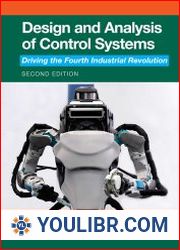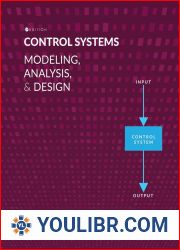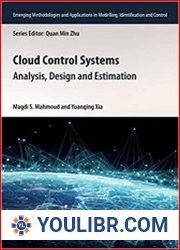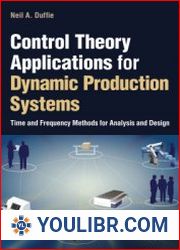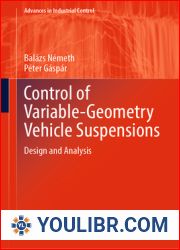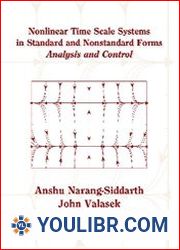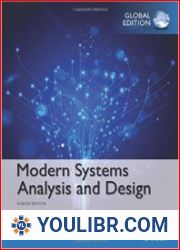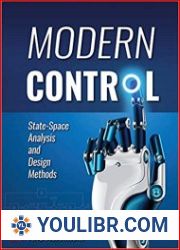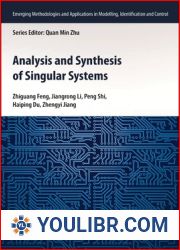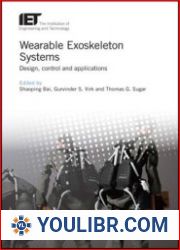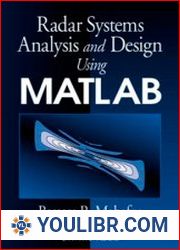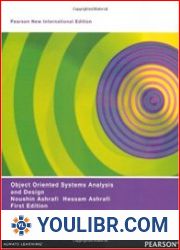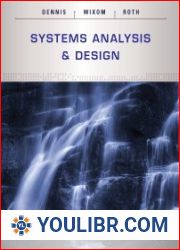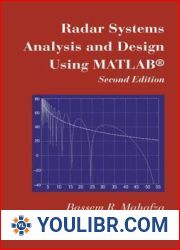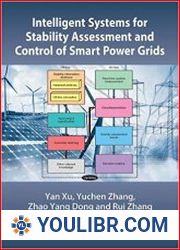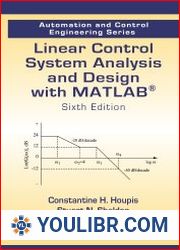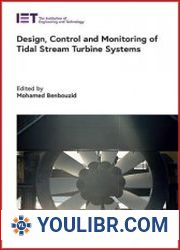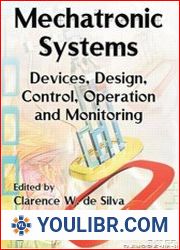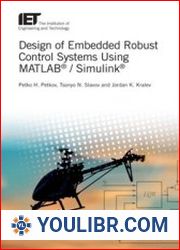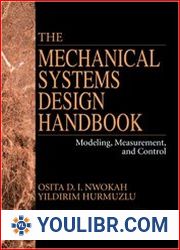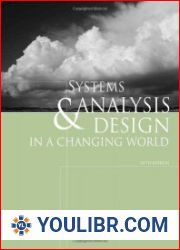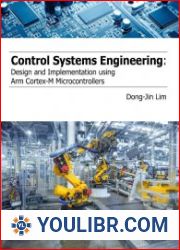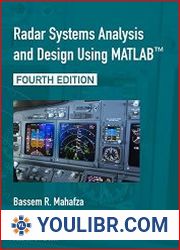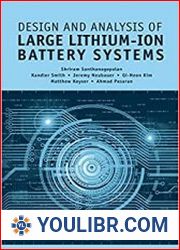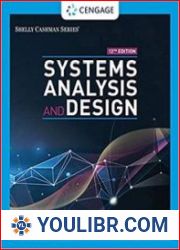
BOOKS - PROGRAMMING - Design and Analysis of Control Systems Driving the Fourth Indus...

Design and Analysis of Control Systems Driving the Fourth Industrial Revolution, Second Edition
Author: Arthur G.O. Mutambara
Year: 2024
Format: PDF
File size: 39.1 MB
Language: ENG
Year: 2024
Format: PDF
File size: 39.1 MB
Language: ENG
Written to inspire and cultivate the ability to design and analyse feasible control algorithms for a wide range of engineering applications, this comprehensive text covers the theoretical and practical principles involved in the design and analysis of control systems. This second edition introduces 4IR adoption strategies for traditional intelligent control, including new techniques of implementing control systems. It provides improved coverage of the characteristics of feedback control, root-locus analysis, frequency-response analysis, state space methods, digital control systems and advanced controls, including updated worked examples and problems. The design and analysis of control systems require tools to enable and speed up the process. There are a number of such computer-based computational tools that can be used. MATLAB and its MATLAB Control System Toolbox are the most popular tools, followed by Simulink Control Design. There is also LabVIEW which is a graphical tool and an alternative programming method to MATLAB. Other tools include SPICE-Based Simulation Software, SimPowerSystems, StateFlow, and Mathcad. With the advent of the Fourth Industrial Revolution (4IR) and extensive use of Artificial Intelligence (AI), there are new advanced methods of designing and analysing control systems. Most of these techniques are data-driven, and more specifically AI-based. To start with, concepts such as Data-Driven Modelling, Artificial Intelligence, Machine Learning, Deep Learning, Fuzzy Logic, and Artificial Neural Networks are introduced and discussed in detail.
제 4 차 산업 혁명에 기여하는 제어 시스템의 설계 및 분석. 제 2 판: 기술의 진화와 인류에 미치는 영향을 이해하기위한 포괄적 인 가이드. 우리가 제 4 차 산업 혁명의 길을 시작함에 따라 기술 발전과 인류에 미치는 영향을 이해하는 것이 중요합니다. 제어 시스템의 설계 및 분석 제 2 판은 제어 시스템의 원칙, 응용 프로그램 및 해당 분야의 최신 개발에 대한 포괄적 인 안내서를 제공합니다. 이 책은 기술 진화에 대한 깊은 이해와 전쟁 국가에 직면 한 인류를 통일 할 수있는 잠재력을 원하는 사람에게는 반드시 읽어야 할 책입니다. 이 책은 피드백 제어, 루트 위치 분석, 주파수 응답 분석, 상태 공간 기술 및 디지털 제어 시스템을 포함한 제어 시스템의 기본 개념을 독자에게 소개하는 것으로 시작합니다. 이러한 원칙은 나중에이 책에서 다루는 고급 주제의 기초가됩니다. 4 차 산업 혁명의 출현으로 인공 지능 (AI), 기계 학습, 딥 러닝 및 퍼지 논리를 사용하여 제어 시스템을 설계하고 분석하는 새로운 방법이 등장했습니다. 이러한 방법은 데이터 중심이며 복잡한 시스템 관리에보다 정교한 접근 방식을 제공합니다. 이 책의 가장 중요한 공헌 중 하나는 현대 지식 개발의 기술 프로세스에 대한 인식을위한 개인 패러다임을 개발할 필요성에 중점을 둡니다. Conception et analyse des systèmes de gestion contribuant à la quatrième révolution industrielle. Deuxième édition : Guide complet pour comprendre l'évolution de la technologie et son impact sur l'humanité. Alors que nous entamons la voie de la quatrième révolution industrielle, il est important de comprendre les progrès technologiques et leur impact sur l'humanité. La deuxième édition de Design and Analysis of Control Systems (Conception et analyse des systèmes de contrôle) fournit un guide complet sur les principes des systèmes de contrôle, leur application et les derniers développements dans ce domaine. Ce livre est obligatoire pour tous ceux qui veulent mieux comprendre l'évolution technologique et son potentiel à unir l'humanité face aux États belligérants. livre commence par familiariser le lecteur avec les concepts fondamentaux des systèmes de contrôle, y compris la gestion par rétroaction, l'analyse du locus racine, l'analyse des caractéristiques de fréquence, les méthodes d'espace d'état et les systèmes de contrôle numériques. Ces principes servent de base à des sujets plus avancés abordés plus loin dans le livre. Avec l'arrivée de la quatrième révolution industrielle, de nouvelles méthodes sont apparues pour concevoir et analyser des systèmes de gestion utilisant l'intelligence artificielle, l'apprentissage automatique, l'apprentissage profond et la logique floue. Ces méthodes sont basées sur des données et offrent une approche plus complexe de la gestion de systèmes complexes. L'une des contributions les plus importantes de ce livre est sa nécessité d'élaborer un paradigme personnel de la perception du processus technologique du développement des connaissances modernes. Diseño y análisis de los sistemas de gestión que contribuyen a la cuarta revolución industrial. Segunda edición: Guía integral para comprender la evolución de la tecnología y su impacto en la humanidad. A medida que iniciamos el camino de la cuarta revolución industrial, es importante comprender los avances tecnológicos y su impacto en la humanidad. La segunda edición de Design and Analysis of Control Systems (Diseño y Análisis de stemas de Control) proporciona una guía exhaustiva sobre los principios de los sistemas de control, sus aplicaciones y los últimos desarrollos en el campo. Este libro es de lectura obligatoria para cualquier persona que quiera obtener una comprensión más profunda de la evolución tecnológica y su potencial para unir a la humanidad frente a los Estados en guerra. libro comienza familiarizando al lector con los conceptos fundamentales de los sistemas de control, incluyendo el control de retroalimentación, análisis de locus raíz, análisis de características de frecuencia, técnicas de espacio de estado y sistemas de control digital. Estos principios sirven de base para los temas más avanzados abordados más tarde en el libro. Con la llegada de la Cuarta Revolución Industrial surgieron nuevas técnicas que permiten diseñar y analizar sistemas de control utilizando inteligencia artificial (IA), aprendizaje automático, aprendizaje profundo y lógica difusa. Estas técnicas se basan en datos y ofrecen un enfoque más sofisticado para administrar sistemas complejos. Una de las contribuciones más significativas de este libro es su enfoque en la necesidad de desarrollar un paradigma personal para percibir el proceso tecnológico del desarrollo del conocimiento moderno. Dördüncü sanayi devrimine katkıda bulunan kontrol sistemlerinin tasarımı ve analizi. İkinci baskı: Teknolojinin evrimini ve insanlık üzerindeki etkisini anlamak için kapsamlı bir rehber. Dördüncü sanayi devrimi yolunda ilerlerken, teknolojik gelişmeleri ve insanlık üzerindeki etkilerini anlamak önemlidir. Kontrol stemlerinin Tasarımı ve Analizi'nin ikinci baskısı, kontrol sistemlerinin ilkeleri, uygulamaları ve alandaki en son gelişmeler hakkında kapsamlı bir rehber sunmaktadır. Bu kitap, teknolojik evrim ve onun insanlığı savaşan devletler karşısında birleştirme potansiyeli hakkında daha derin bir anlayış isteyen herkes için okunması gereken bir kitaptır. Kitap, okuyucuya geri besleme kontrolü, kök lokus analizi, frekans yanıtı analizi, durum uzayı teknikleri ve dijital kontrol sistemleri dahil olmak üzere kontrol sistemlerinin temel kavramlarını tanıtarak başlar. Bu ilkeler, daha sonra kitapta ele alınan daha ileri konuların temelini oluşturur. Dördüncü Sanayi Devrimi'nin ortaya çıkmasıyla, kontrol sistemlerini yapay zeka (AI), makine öğrenimi, derin öğrenme ve bulanık mantık kullanarak tasarlamak ve analiz etmek için yeni yöntemler ortaya çıktı. Bu yöntemler veri odaklıdır ve karmaşık sistemleri yönetmek için daha sofistike bir yaklaşım sunar. Bu kitabın en önemli katkılarından biri, modern bilginin gelişiminin teknolojik sürecinin algılanması için kişisel bir paradigma geliştirme ihtiyacına odaklanmasıdır. Progettazione e analisi dei sistemi di gestione che contribuiscono alla quarta rivoluzione industriale. Seconda edizione: Una guida completa per comprendere l'evoluzione della tecnologia e i suoi effetti sull'umanità. Mentre iniziamo la quarta rivoluzione industriale, è importante comprendere i progressi tecnologici e il loro impatto sull'umanità. La seconda edizione di Design and Analysis of Control Systems (Progettazione e analisi dei sistemi di gestione) fornisce una guida completa ai sistemi di gestione, alle applicazioni e agli sviluppi più recenti in questo campo. Questo libro è obbligatorio per tutti coloro che desiderano una maggiore comprensione dell'evoluzione tecnologica e del suo potenziale per unire l'umanità di fronte agli stati in conflitto. Il libro inizia con la conoscenza da parte del lettore dei concetti fondamentali dei sistemi di gestione, tra cui la gestione con feedback, l'analisi del locus radice, l'analisi delle frequenze, le tecniche di spazio degli stati e i sistemi di controllo digitali. Questi principi sono la base per argomenti più avanzati trattati successivamente nel libro. Con la Quarta Rivoluzione Industriale, sono emerse nuove tecniche per progettare e analizzare i sistemi di controllo utilizzando intelligenza artificiale (IA), apprendimento automatico, apprendimento approfondito e logica impreziosita. Questi metodi sono basati sui dati e offrono un approccio più complesso alla gestione dei sistemi complessi. Uno dei contributi più significativi di questo libro è il suo orientamento sulla necessità di sviluppare un paradigma personale per la percezione del processo tecnologico di sviluppo della conoscenza moderna. Entwurf und Analyse von Steuerungssystemen, die zur vierten industriellen Revolution beitragen. Zweite Ausgabe: Ein umfassender itfaden zum Verständnis der Entwicklung der Technologie und ihrer Auswirkungen auf die Menschheit. Während wir den Weg der vierten industriellen Revolution beginnen, ist es wichtig, den technologischen Fortschritt und seine Auswirkungen auf die Menschheit zu verstehen. Die zweite Ausgabe von „Design and Analysis of Control Systems“ enthält eine umfassende Anleitung zu den Prinzipien von Steuerungssystemen, deren Anwendung und den neuesten Entwicklungen auf diesem Gebiet. Dieses Buch ist ein Muss für alle, die ein tieferes Verständnis der technologischen Entwicklung und ihres Potenzials, die Menschheit angesichts der verfeindeten Staaten zu vereinen, erlangen möchten. Das Buch beginnt damit, den ser mit den grundlegenden Konzepten von Steuerungssystemen vertraut zu machen, einschließlich der Regelung, der Wurzelortanalyse, der Analyse des Frequenzverhaltens, der Zustandsraumtechniken und der digitalen Steuerungssysteme. Diese Prinzipien dienen als Grundlage für fortgeschrittenere Themen, die später im Buch behandelt werden. Mit dem Aufkommen der vierten industriellen Revolution sind neue Techniken entstanden, die es ermöglichen, Steuerungssysteme mit künstlicher Intelligenz (KI), maschinellem rnen, Deep arning und Fuzzy-Logik zu entwerfen und zu analysieren. Diese Methoden sind datengesteuert und bieten einen komplexeren Ansatz zur Verwaltung komplexer Systeme. Einer der wichtigsten Beiträge dieses Buches ist sein Fokus auf die Notwendigkeit, ein persönliches Paradigma für die Wahrnehmung des technologischen Prozesses der Entwicklung des modernen Wissens zu entwickeln. Projektowanie i analiza systemów sterowania przyczyniających się do czwartej rewolucji przemysłowej. Drugie wydanie: Kompleksowy przewodnik do zrozumienia ewolucji technologii i jej wpływu na ludzkość. Kiedy wkraczamy na drogę czwartej rewolucji przemysłowej, ważne jest zrozumienie postępu technologicznego i ich wpływu na ludzkość. Druga edycja Projektu i Analizy Systemów Sterowania stanowi kompleksowy przewodnik po zasadach systemów sterowania, ich stosowaniu oraz najnowszych osiągnięciach w tej dziedzinie. Ta książka jest konieczna dla każdego, kto chce głębszego zrozumienia ewolucji technologicznej i jej potencjału do zjednoczenia ludzkości w obliczu walczących państw. Książka rozpoczyna się od wprowadzenia czytelnika do podstawowych koncepcji systemów sterowania, w tym kontroli sprzężenia zwrotnego, analizy lokalizacji korzeniowej, analizy reakcji częstotliwości, technik przestrzeni stanowej i systemów sterowania cyfrowego. Zasady te służą jako podstawa bardziej zaawansowanych tematów omówionych później w książce. Wraz z nadejściem czwartej rewolucji przemysłowej pojawiły się nowe metody projektowania i analizy systemów sterowania przy użyciu sztucznej inteligencji (AI), uczenia maszynowego, głębokiego uczenia się i rozmytej logiki. Metody te są oparte na danych i oferują bardziej wyrafinowane podejście do zarządzania złożonymi systemami. Jednym z najważniejszych wkładów tej książki jest skupienie się na potrzebie opracowania osobistego paradygmatu postrzegania technologicznego procesu rozwoju nowoczesnej wiedzy. 促進第四次工業革命的管理系統的設計和分析。第二版:了解技術演變及其對人類影響的綜合指南。當我們開始第四次工業革命的道路時,重要的是要了解技術進步及其對人類的影響。第二版的《控制系統的設計和分析》就控制系統的原則、應用以及該領域的最新發展提供了全面的指導。這本書對於任何希望更好地了解技術演變及其在交戰國家面前團結人類的潛力的人來說都是必須閱讀的。本書首先使讀者熟悉控制系統的基本概念,包括反饋控制,根位點分析,頻率特性分析,狀態空間方法和數字控制系統。這些原則為書中後來提出的更高級的主題提供了基礎。隨著第四次工業革命的到來,出現了使用人工智能(AI),機器學習,深度學習和模糊邏輯設計和分析控制系統的新方法。這些方法基於數據,為復雜系統的管理提供了更復雜的方法。本書最重要的貢獻之一是著重於對現代知識發展的過程感知的個人範式。
Проектирование и анализ систем управления, способствующих четвертой промышленной революции. Второе издание: Всеобъемлющее руководство по пониманию эволюции технологии и ее воздействия на человечество. По мере того, как мы начинаем путь четвертой промышленной революции, важно понимать технологические достижения и их влияние на человечество. Второе издание «Design and Analysis of Control Systems» (Проектирование и анализ систем управления) содержит исчерпывающее руководство по принципам систем управления, их применению и последним разработкам в данной области. Эта книга обязательна к прочтению для всех, кто хочет получить более глубокое понимание технологической эволюции и ее потенциала по объединению человечества перед лицом враждующих государств. Книга начинается с знакомства читателя с фундаментальными понятиями систем управления, включая управление с обратной связью, анализ корневого локуса, анализ частотных характеристик, методы пространства состояний и цифровые системы управления. Эти принципы служат основой для более продвинутых тем, затронутых позже в книге. С приходом Четвертой промышленной революции появились новые методы, позволяющие проектировать и анализировать системы управления с использованием искусственного интеллекта (ИИ), машинного обучения, глубокого обучения и нечеткой логики. Эти методы основаны на данных и предлагают более сложный подход к управлению сложными системами. Одним из наиболее значительных вкладов этой книги является её направленность на необходимость выработки личностной парадигмы восприятия технологического процесса развития современных знаний. Engenharia e análise de sistemas de gestão que contribuem para a quarta revolução industrial. Segunda edição: Guia abrangente para compreender a evolução da tecnologia e seus efeitos na humanidade. À medida que começamos o caminho da quarta revolução industrial, é importante compreender os avanços tecnológicos e seus efeitos na humanidade. A segunda edição de Design e Análise de stemas de Controle contém um guia completo sobre os princípios dos sistemas de controle, suas aplicações e os últimos desenvolvimentos nesta área. Este livro é obrigatório para todos aqueles que desejam uma compreensão mais profunda da evolução tecnológica e do seu potencial de unir a humanidade face aos estados rivais. O livro começa com a familiaridade do leitor com conceitos fundamentais de sistemas de controle, incluindo controle com feedback, análise de locus de raiz, análise de frequência, métodos de espaço de estado e sistemas digitais de controle. Estes princípios servem de base para temas mais avançados abordados mais tarde no livro. Com a chegada da Quarta Revolução Industrial, novas técnicas surgiram para projetar e analisar sistemas de controle com inteligência artificial (IA), aprendizagem de máquinas, aprendizagem profunda e lógica ímpar. Estes métodos são baseados em dados e oferecem uma abordagem mais complexa da gestão de sistemas complexos. Uma das contribuições mais significativas deste livro é a sua orientação para a necessidade de estabelecer um paradigma pessoal de percepção do processo tecnológico de desenvolvimento do conhecimento moderno. تصميم وتحليل نظم التحكم المساهمة في الثورة الصناعية الرابعة. الطبعة الثانية: دليل شامل لفهم تطور التكنولوجيا وأثرها على البشرية. وبينما نشرع في طريق الثورة الصناعية الرابعة، من المهم فهم التقدم التكنولوجي وتأثيره على البشرية. توفر الطبعة الثانية من تصميم وتحليل نظم التحكم دليلاً شاملاً لمبادئ نظم التحكم وتطبيقاتها وآخر التطورات في هذا المجال. هذا الكتاب يجب قراءته لأي شخص يريد فهمًا أعمق للتطور التكنولوجي وإمكانية توحيد البشرية في مواجهة الدول المتحاربة. يبدأ الكتاب بتعريف القارئ بالمفاهيم الأساسية لأنظمة التحكم، بما في ذلك التحكم في التغذية المرتدة، وتحليل موقع الجذر، وتحليل استجابة التردد، وتقنيات الفضاء الحكومية، وأنظمة التحكم الرقمية. تستخدم هذه المبادئ كأساس للمواضيع الأكثر تقدمًا التي تمت تغطيتها لاحقًا في الكتاب. مع ظهور الثورة الصناعية الرابعة، ظهرت طرق جديدة لتصميم وتحليل أنظمة التحكم باستخدام الذكاء الاصطناعي (AI) والتعلم الآلي والتعلم العميق والمنطق الغامض. هذه الأساليب تعتمد على البيانات وتوفر نهجًا أكثر تطورًا لإدارة الأنظمة المعقدة. من أهم مساهمات هذا الكتاب تركيزه على الحاجة إلى تطوير نموذج شخصي لتصور العملية التكنولوجية لتطوير المعرفة الحديثة. Design and Analysis of Control Systems Driving the Fourth Industrial Revolution Second Edition: A Comprehensive Guide to Understanding the Evolution of Technology and Its Impact on Humanity As we embark on the journey of the Fourth Industrial Revolution, it is essential to understand the technological advancements and their impact on humanity. The second edition of "Design and Analysis of Control Systems" provides a comprehensive guide to the principles of control systems, their applications, and the latest developments in the field. This book is a must-read for anyone looking to gain a deeper understanding of the technological evolution and its potential to unify humanity in the face of warring states. The book begins by introducing the reader to the fundamental concepts of control systems, including feedback control, root locus analysis, frequency response analysis, state space methods, and digital control systems. These principles serve as the foundation for the more advanced topics covered later in the book. With the advent of the Fourth Industrial Revolution, new techniques have emerged that enable the design and analysis of control systems using artificial intelligence (AI), machine learning, deep learning, and fuzzy logic. These methods are data-driven and offer a more sophisticated approach to controlling complex systems. One of the most significant contributions of this book is its focus on the need to develop a personal paradigm for perceiving the technological process of developing modern knowledge. 第4次産業革命に貢献する制御システムの設計と分析。第2版:テクノロジーの進化と人類への影響を理解するための包括的なガイド。第4次産業革命の道を歩むにあたり、技術の進歩と人類への影響を理解することが重要です。制御システムの設計と分析の第二版は、制御システムの原則、そのアプリケーション、および分野の最新の開発に関する包括的なガイドを提供します。この本は、戦争状態に直面して人類を団結させる技術の進化とその可能性をより深く理解したい人にとって必読です。まずは、フィードバック制御、ルートローカス解析、周波数応答解析、状態空間技術、デジタル制御システムなど、制御システムの基本的な概念を読者に紹介します。これらの原則は、後に本で取り上げられたより高度なトピックの基礎となる。第4次産業革命の到来により、人工知能(AI)、機械学習、ディープラーニング、ファジーロジックを使用して制御システムを設計および分析する新しい方法が登場しました。これらの方法はデータ駆動型であり、複雑なシステムを管理するためのより高度なアプローチを提供します。この本の最も重要な貢献の一つは、現代の知識の発展の技術的プロセスの認識のための個人的なパラダイムを開発する必要性に焦点を当てることである。 עיצוב וניתוח מערכות בקרה התורמים למהפכה התעשייתית הרביעית. מהדורה שנייה: מדריך מקיף להבנת התפתחות הטכנולוגיה והשפעתה על האנושות. כשאנו יוצאים לדרך המהפכה התעשייתית הרביעית, חשוב להבין את ההתקדמות הטכנולוגית ואת השפעתם על האנושות. המהדורה השנייה של Design and Analysis of Control Systems מספקת מדריך מקיף לעקרונות של מערכות בקרה, יישומם, וההתפתחויות האחרונות בתחום. הספר הזה הוא קריאת חובה לכל מי שרוצה הבנה עמוקה יותר של האבולוציה הטכנולוגית והפוטנציאל שלה לאחד את האנושות מול מדינות לוחמות. הספר מתחיל בכך שהוא מציג לקורא מושגים בסיסיים של מערכות בקרה, כולל בקרת משוב, ניתוח לוקוס שורש, ניתוח תגובת תדר, טכניקות חלל מצב ומערכות בקרה דיגיטליות. עקרונות אלה משמשים בסיס לנושאים מתקדמים יותר המכוסים מאוחר יותר בספר. עם תחילת המהפכה התעשייתית הרביעית, נוצרו שיטות חדשות לתכנון וניתוח מערכות בקרה באמצעות בינה מלאכותית (AI), למידת מכונה, למידה עמוקה ולוגיקה מעורפלת. שיטות אלו מונעות נתונים ומציעות גישה מתוחכמת יותר לניהול מערכות מורכבות. אחת התרומות המשמעותיות ביותר של ספר זה היא התמקדותו בצורך לפתח פרדיגמה אישית לתפיסה של התהליך הטכנולוגי של התפתחות הידע המודרני. descargar archivo pdf download pdf file pdf dosyasını indir להוריד קובץ PDF pdf 파일 다운로드 PDF-Datei herunterladen скачать файл PDF 下载 pdf 文件 تنزيل ملف pdf PDFファイルをダウンロード Scarica il file pdf descarregar ficheiro pdf download pdf file pobierz plik pdf télécharger le fichier pdf
Написанный для того, чтобы вдохновить и развить способность проектировать и анализировать выполнимые алгоритмы управления для широкого спектра инженерных приложений, этот всеобъемлющий текст охватывает теоретические и практические принципы, связанные с проектированием и анализом систем управления. В этом втором издании представлены 4IR стратегии внедрения традиционного интеллектуального управления, включая новые методы внедрения систем управления. Он обеспечивает улучшенный охват характеристик управления с обратной связью, анализа «корень-локус», анализа «частота-отклик», методов пространства состояний, цифровых систем управления и расширенного управления, включая обновленные проработанные примеры и проблемы. Проектирование и анализ систем управления требуют инструментов для обеспечения и ускорения процесса. Существует ряд таких компьютерных вычислительных средств, которые можно использовать. MATLAB и его MATLAB Control System Toolbox являются наиболее популярными инструментами, за ними следует mulink Control Design. Существует также LabVIEW - графический инструмент и альтернативный MATLAB метод программирования. Другие инструменты включают программное обеспечение для моделирования на основе SPICE, mPowerSystems, StateFlow и Mathcad. С приходом Четвертой промышленной революции (4IR) и широким использованием искусственного интеллекта (ИИ) появились новые передовые методы проектирования и анализа систем управления. Большинство из этих методов основаны на данных и, в частности, на ИИ. Для начала вводятся и подробно обсуждаются такие концепции, как Data-Driven Modeling, Artificial Intelligence, Machine arning, Deep arning, Fuzzy Logic и Artificial Neural Networks.
Escrito con el fin de inspirar y desarrollar la capacidad de diseñar y analizar algoritmos de control factibles para una amplia gama de aplicaciones de ingeniería, este texto integral abarca principios teóricos y prácticos relacionados con el diseño y análisis de sistemas de control. Esta segunda edición presenta 4IR estrategias para implementar la gestión inteligente tradicional, incluyendo nuevas técnicas para implementar sistemas de control. Proporciona una cobertura mejorada de las características de control con retroalimentación, análisis raíz-locus, análisis frecuencia-respuesta, técnicas de espacio de estado, sistemas de control digital y administración avanzada, incluyendo ejemplos y problemas actualizados y elaborados. El diseño y el análisis de los sistemas de control requieren herramientas para garantizar y acelerar el proceso. Hay una serie de herramientas informáticas que se pueden utilizar. MATLAB y su MATLAB Control System Toolbox son las herramientas más populares, seguidas por Simulink Control Design. También existe LabVIEW, una herramienta gráfica y un método de programación MATLAB alternativo. Otras herramientas incluyen software de modelado basado en SPICE, SimPowerSystems, StateFlow y Mathcad. Con la llegada de la Cuarta Revolución Industrial (4IR) y el amplio uso de la inteligencia artificial (IA), surgieron nuevas técnicas avanzadas de diseño y análisis de sistemas de control. La mayoría de estos métodos se basan en datos y, en particular, en la IA. Para empezar, se introducen conceptos como Data-Driven Modeling, Inteligencia Artificial, Aprendizaje de Máquina, Aprendizaje Profundo, Fuzzy Logic y Redes Neurales Artificiales y se discuten detalladamente.
Escrito para inspirar e desenvolver a capacidade de projetar e analisar algoritmos de controle viáveis para uma ampla gama de aplicações de engenharia, este texto abrangente abrange os princípios teóricos e práticos relacionados à concepção e análise de sistemas de controle. Esta segunda edição apresenta estratégias 4IR para implementar a gestão inteligente tradicional, incluindo novas técnicas de implementação de sistemas de gestão. Oferece um melhor alcance das características de controle com feedback, análise de raiz-locus, análise de frequência-resposta, técnicas de espaço de estado, sistemas digitais de controle e controle avançado, incluindo exemplos atualizados e problemas. Projetar e analisar sistemas de controle requer ferramentas para garantir e acelerar o processo. Há uma série de ferramentas computacionais que podem ser usadas. O MATLAB e o MATLAB System System Toolbox são as ferramentas mais populares, seguidas pelo Simulink Control Design. Há também uma ferramenta gráfica e um método de programação alternativo MATLAB. Outras ferramentas incluem software de simulação baseado em SPICE, SimPowerSystems, StateFlow e Mathcad. Com a chegada da Quarta Revolução Industrial (4IR) e a ampla utilização da inteligência artificial (IA), novas técnicas avançadas de engenharia e análise de sistemas de gestão surgiram. A maioria destas técnicas são baseadas em dados e, em particular, em IA. Para começar, conceitos como o Data-Driven Modeling, a Inteligência Artística, a Máquina Learning, a Deep Learning, a Fuzzy Logic e a Artial Neural Networks são introduzidos e discutidos detalhadamente.
Written to inspire and cultivate the ability to design and analyse feasible control algorithms for a wide range of engineering applications, this comprehensive text covers the theoretical and practical principles involved in the design and analysis of control systems. This second edition introduces 4IR adoption strategies for traditional intelligent control, including new techniques of implementing control systems. It provides improved coverage of the characteristics of feedback control, root-locus analysis, frequency-response analysis, state space methods, digital control systems and advanced controls, including updated worked examples and problems. The design and analysis of control systems require tools to enable and speed up the process. There are a number of such computer-based computational tools that can be used. MATLAB and its MATLAB Control System Toolbox are the most popular tools, followed by Simulink Control Design. There is also LabVIEW which is a graphical tool and an alternative programming method to MATLAB. Other tools include SPICE-Based Simulation Software, SimPowerSystems, StateFlow, and Mathcad. With the advent of the Fourth Industrial Revolution (4IR) and extensive use of Artificial Intelligence (AI), there are new advanced methods of designing and analysing control systems. Most of these techniques are data-driven, and more specifically AI-based. To start with, concepts such as Data-Driven Modelling, Artificial Intelligence, Machine Learning, Deep Learning, Fuzzy Logic, and Artificial Neural Networks are introduced and discussed in detail.
Scritto per ispirare e sviluppare la capacità di progettare e analizzare algoritmi di gestione fattibili per una vasta gamma di applicazioni di ingegneria, questo testo completo comprende i principi teorici e pratici relativi alla progettazione e all'analisi dei sistemi di gestione. Questa seconda edizione presenta le strategie 4IR per l'implementazione della gestione intelligente tradizionale, incluse le nuove modalità di implementazione dei sistemi di gestione. Offre una migliore copertura delle funzionalità di gestione con feedback, root-locus, frequenza-risposta, metodi di stato, gestione digitale e gestione avanzata, inclusi esempi e problemi aggiornati. La progettazione e l'analisi dei sistemi di gestione richiedono strumenti per garantire e accelerare il processo. Esistono diversi strumenti informatici che possono essere utilizzati. MATLAB e il suo MATLAB Control System Toolbox sono gli strumenti più popolari, seguiti da Simulink Control Design. C'è anche uno strumento grafico e un metodo di programmazione alternativo a MATLAB. Altri strumenti includono software di simulazione basato su SPICE, SimPowerSystems, StateFlow e Mathcad. Con l'avvento della Quarta Rivoluzione Industriale (4IR) e l'uso diffuso dell'intelligenza artificiale (IA), sono emerse nuove best practice per la progettazione e l'analisi dei sistemi di gestione. La maggior parte di questi metodi sono basati sui dati e in particolare sull'IA. Per cominciare, vengono introdotti e approfonditi concetti quali Data-Driven Modeling, Artigial Intelligence, Machine Learning, Deep Learning, Fuzzy Logic e Artigial Neurale Networks.
Écrit pour inspirer et développer la capacité de concevoir et d'analyser des algorithmes de contrôle réalisables pour un large éventail d'applications d'ingénierie, ce texte complet couvre les principes théoriques et pratiques liés à la conception et à l'analyse des systèmes de contrôle. Cette deuxième édition présente les stratégies 4IR de mise en œuvre de la gestion intelligente traditionnelle, y compris les nouvelles méthodes de mise en œuvre des systèmes de gestion. Il offre une meilleure couverture des caractéristiques de contrôle de rétroaction, d'analyse racine-locus, d'analyse fréquence-réponse, de méthodes d'espace d'état, de systèmes de contrôle numériques et de contrôle avancé, y compris des exemples et des problèmes mis à jour. La conception et l'analyse des systèmes de gestion nécessitent des outils pour assurer et accélérer le processus. Il existe un certain nombre de ces outils informatiques qui peuvent être utilisés. MATLAB et son MATLAB Control System Toolbox sont les outils les plus populaires, suivis par Simulink Control Design. Il existe également LabVIEW, un outil graphique et une autre méthode de programmation MATLAB. D'autres outils incluent des logiciels de simulation basés sur SPICE, SimPowerSystems, StateFlow et Mathcad. Avec l'arrivée de la quatrième révolution industrielle (4IR) et l'utilisation généralisée de l'intelligence artificielle (IA), de nouvelles meilleures pratiques de conception et d'analyse des systèmes de gestion sont apparues. La plupart de ces méthodes sont basées sur des données et en particulier sur l'IA. Pour commencer, des concepts tels que Data-Driven Modeling, Artificial Intelligence, Machine Learning, Deep Learning, Fuzzy Logic et Artificial Neural Networks sont introduits et discutés en détail.
Geschrieben, um die Fähigkeit zu inspirieren und zu entwickeln, durchführbare Steuerungsalgorithmen für eine breite Palette von technischen Anwendungen zu entwerfen und zu analysieren, umfasst dieser umfassende Text die theoretischen und praktischen Grundlagen im Zusammenhang mit dem Entwurf und der Analyse von Steuerungssystemen. In dieser zweiten Ausgabe werden 4IR Strategien zur Einführung des traditionellen intelligenten Managements vorgestellt, einschließlich neuer Methoden zur Einführung von Managementsystemen. Es bietet eine verbesserte Abdeckung von Regelungsmerkmalen, Wurzel-Ort-Analyse, Frequenz-Antwort-Analyse, Zustandsraumtechniken, digitalen Steuerungssystemen und erweiterter Steuerung, einschließlich aktualisierter, ausgearbeiteter Beispiele und Probleme. Das Design und die Analyse von Steuerungssystemen erfordern Werkzeuge, um den Prozess zu gewährleisten und zu beschleunigen. Es gibt eine Reihe solcher Computercomputerwerkzeuge, die verwendet werden können. MATLAB und seine MATLAB Control System Toolbox sind die beliebtesten Tools, gefolgt von Simulink Control Design. Es gibt auch LabVIEW, ein grafisches Werkzeug und eine alternative MATLAB-Programmiermethode. Weitere Tools sind SPICE-basierte Simulationssoftware, SimPowerSystems, StateFlow und Mathcad. Mit dem Aufkommen der vierten industriellen Revolution (4IR) und dem weit verbreiteten Einsatz künstlicher Intelligenz (KI) sind neue fortschrittliche Techniken für das Design und die Analyse von Steuerungssystemen entstanden. Die meisten dieser Methoden basieren auf Daten und insbesondere auf KI. Zunächst werden Konzepte wie Data-Driven Modeling, Artificial Intelligence, Machine Learning, Deep Learning, Fuzzy Logic und Artificial Neural Networks vorgestellt und ausführlich diskutiert.
Написанный для того, чтобы вдохновить и развить способность проектировать и анализировать выполнимые алгоритмы управления для широкого спектра инженерных приложений, этот всеобъемлющий текст охватывает теоретические и практические принципы, связанные с проектированием и анализом систем управления. В этом втором издании представлены 4IR стратегии внедрения традиционного интеллектуального управления, включая новые методы внедрения систем управления. Он обеспечивает улучшенный охват характеристик управления с обратной связью, анализа «корень-локус», анализа «частота-отклик», методов пространства состояний, цифровых систем управления и расширенного управления, включая обновленные проработанные примеры и проблемы. Проектирование и анализ систем управления требуют инструментов для обеспечения и ускорения процесса. Существует ряд таких компьютерных вычислительных средств, которые можно использовать. MATLAB и его MATLAB Control System Toolbox являются наиболее популярными инструментами, за ними следует mulink Control Design. Существует также LabVIEW - графический инструмент и альтернативный MATLAB метод программирования. Другие инструменты включают программное обеспечение для моделирования на основе SPICE, mPowerSystems, StateFlow и Mathcad. С приходом Четвертой промышленной революции (4IR) и широким использованием искусственного интеллекта (ИИ) появились новые передовые методы проектирования и анализа систем управления. Большинство из этих методов основаны на данных и, в частности, на ИИ. Для начала вводятся и подробно обсуждаются такие концепции, как Data-Driven Modeling, Artificial Intelligence, Machine arning, Deep arning, Fuzzy Logic и Artificial Neural Networks.
Escrito con el fin de inspirar y desarrollar la capacidad de diseñar y analizar algoritmos de control factibles para una amplia gama de aplicaciones de ingeniería, este texto integral abarca principios teóricos y prácticos relacionados con el diseño y análisis de sistemas de control. Esta segunda edición presenta 4IR estrategias para implementar la gestión inteligente tradicional, incluyendo nuevas técnicas para implementar sistemas de control. Proporciona una cobertura mejorada de las características de control con retroalimentación, análisis raíz-locus, análisis frecuencia-respuesta, técnicas de espacio de estado, sistemas de control digital y administración avanzada, incluyendo ejemplos y problemas actualizados y elaborados. El diseño y el análisis de los sistemas de control requieren herramientas para garantizar y acelerar el proceso. Hay una serie de herramientas informáticas que se pueden utilizar. MATLAB y su MATLAB Control System Toolbox son las herramientas más populares, seguidas por Simulink Control Design. También existe LabVIEW, una herramienta gráfica y un método de programación MATLAB alternativo. Otras herramientas incluyen software de modelado basado en SPICE, SimPowerSystems, StateFlow y Mathcad. Con la llegada de la Cuarta Revolución Industrial (4IR) y el amplio uso de la inteligencia artificial (IA), surgieron nuevas técnicas avanzadas de diseño y análisis de sistemas de control. La mayoría de estos métodos se basan en datos y, en particular, en la IA. Para empezar, se introducen conceptos como Data-Driven Modeling, Inteligencia Artificial, Aprendizaje de Máquina, Aprendizaje Profundo, Fuzzy Logic y Redes Neurales Artificiales y se discuten detalladamente.
Escrito para inspirar e desenvolver a capacidade de projetar e analisar algoritmos de controle viáveis para uma ampla gama de aplicações de engenharia, este texto abrangente abrange os princípios teóricos e práticos relacionados à concepção e análise de sistemas de controle. Esta segunda edição apresenta estratégias 4IR para implementar a gestão inteligente tradicional, incluindo novas técnicas de implementação de sistemas de gestão. Oferece um melhor alcance das características de controle com feedback, análise de raiz-locus, análise de frequência-resposta, técnicas de espaço de estado, sistemas digitais de controle e controle avançado, incluindo exemplos atualizados e problemas. Projetar e analisar sistemas de controle requer ferramentas para garantir e acelerar o processo. Há uma série de ferramentas computacionais que podem ser usadas. O MATLAB e o MATLAB System System Toolbox são as ferramentas mais populares, seguidas pelo Simulink Control Design. Há também uma ferramenta gráfica e um método de programação alternativo MATLAB. Outras ferramentas incluem software de simulação baseado em SPICE, SimPowerSystems, StateFlow e Mathcad. Com a chegada da Quarta Revolução Industrial (4IR) e a ampla utilização da inteligência artificial (IA), novas técnicas avançadas de engenharia e análise de sistemas de gestão surgiram. A maioria destas técnicas são baseadas em dados e, em particular, em IA. Para começar, conceitos como o Data-Driven Modeling, a Inteligência Artística, a Máquina Learning, a Deep Learning, a Fuzzy Logic e a Artial Neural Networks são introduzidos e discutidos detalhadamente.
Written to inspire and cultivate the ability to design and analyse feasible control algorithms for a wide range of engineering applications, this comprehensive text covers the theoretical and practical principles involved in the design and analysis of control systems. This second edition introduces 4IR adoption strategies for traditional intelligent control, including new techniques of implementing control systems. It provides improved coverage of the characteristics of feedback control, root-locus analysis, frequency-response analysis, state space methods, digital control systems and advanced controls, including updated worked examples and problems. The design and analysis of control systems require tools to enable and speed up the process. There are a number of such computer-based computational tools that can be used. MATLAB and its MATLAB Control System Toolbox are the most popular tools, followed by Simulink Control Design. There is also LabVIEW which is a graphical tool and an alternative programming method to MATLAB. Other tools include SPICE-Based Simulation Software, SimPowerSystems, StateFlow, and Mathcad. With the advent of the Fourth Industrial Revolution (4IR) and extensive use of Artificial Intelligence (AI), there are new advanced methods of designing and analysing control systems. Most of these techniques are data-driven, and more specifically AI-based. To start with, concepts such as Data-Driven Modelling, Artificial Intelligence, Machine Learning, Deep Learning, Fuzzy Logic, and Artificial Neural Networks are introduced and discussed in detail.
Scritto per ispirare e sviluppare la capacità di progettare e analizzare algoritmi di gestione fattibili per una vasta gamma di applicazioni di ingegneria, questo testo completo comprende i principi teorici e pratici relativi alla progettazione e all'analisi dei sistemi di gestione. Questa seconda edizione presenta le strategie 4IR per l'implementazione della gestione intelligente tradizionale, incluse le nuove modalità di implementazione dei sistemi di gestione. Offre una migliore copertura delle funzionalità di gestione con feedback, root-locus, frequenza-risposta, metodi di stato, gestione digitale e gestione avanzata, inclusi esempi e problemi aggiornati. La progettazione e l'analisi dei sistemi di gestione richiedono strumenti per garantire e accelerare il processo. Esistono diversi strumenti informatici che possono essere utilizzati. MATLAB e il suo MATLAB Control System Toolbox sono gli strumenti più popolari, seguiti da Simulink Control Design. C'è anche uno strumento grafico e un metodo di programmazione alternativo a MATLAB. Altri strumenti includono software di simulazione basato su SPICE, SimPowerSystems, StateFlow e Mathcad. Con l'avvento della Quarta Rivoluzione Industriale (4IR) e l'uso diffuso dell'intelligenza artificiale (IA), sono emerse nuove best practice per la progettazione e l'analisi dei sistemi di gestione. La maggior parte di questi metodi sono basati sui dati e in particolare sull'IA. Per cominciare, vengono introdotti e approfonditi concetti quali Data-Driven Modeling, Artigial Intelligence, Machine Learning, Deep Learning, Fuzzy Logic e Artigial Neurale Networks.
Écrit pour inspirer et développer la capacité de concevoir et d'analyser des algorithmes de contrôle réalisables pour un large éventail d'applications d'ingénierie, ce texte complet couvre les principes théoriques et pratiques liés à la conception et à l'analyse des systèmes de contrôle. Cette deuxième édition présente les stratégies 4IR de mise en œuvre de la gestion intelligente traditionnelle, y compris les nouvelles méthodes de mise en œuvre des systèmes de gestion. Il offre une meilleure couverture des caractéristiques de contrôle de rétroaction, d'analyse racine-locus, d'analyse fréquence-réponse, de méthodes d'espace d'état, de systèmes de contrôle numériques et de contrôle avancé, y compris des exemples et des problèmes mis à jour. La conception et l'analyse des systèmes de gestion nécessitent des outils pour assurer et accélérer le processus. Il existe un certain nombre de ces outils informatiques qui peuvent être utilisés. MATLAB et son MATLAB Control System Toolbox sont les outils les plus populaires, suivis par Simulink Control Design. Il existe également LabVIEW, un outil graphique et une autre méthode de programmation MATLAB. D'autres outils incluent des logiciels de simulation basés sur SPICE, SimPowerSystems, StateFlow et Mathcad. Avec l'arrivée de la quatrième révolution industrielle (4IR) et l'utilisation généralisée de l'intelligence artificielle (IA), de nouvelles meilleures pratiques de conception et d'analyse des systèmes de gestion sont apparues. La plupart de ces méthodes sont basées sur des données et en particulier sur l'IA. Pour commencer, des concepts tels que Data-Driven Modeling, Artificial Intelligence, Machine Learning, Deep Learning, Fuzzy Logic et Artificial Neural Networks sont introduits et discutés en détail.
Geschrieben, um die Fähigkeit zu inspirieren und zu entwickeln, durchführbare Steuerungsalgorithmen für eine breite Palette von technischen Anwendungen zu entwerfen und zu analysieren, umfasst dieser umfassende Text die theoretischen und praktischen Grundlagen im Zusammenhang mit dem Entwurf und der Analyse von Steuerungssystemen. In dieser zweiten Ausgabe werden 4IR Strategien zur Einführung des traditionellen intelligenten Managements vorgestellt, einschließlich neuer Methoden zur Einführung von Managementsystemen. Es bietet eine verbesserte Abdeckung von Regelungsmerkmalen, Wurzel-Ort-Analyse, Frequenz-Antwort-Analyse, Zustandsraumtechniken, digitalen Steuerungssystemen und erweiterter Steuerung, einschließlich aktualisierter, ausgearbeiteter Beispiele und Probleme. Das Design und die Analyse von Steuerungssystemen erfordern Werkzeuge, um den Prozess zu gewährleisten und zu beschleunigen. Es gibt eine Reihe solcher Computercomputerwerkzeuge, die verwendet werden können. MATLAB und seine MATLAB Control System Toolbox sind die beliebtesten Tools, gefolgt von Simulink Control Design. Es gibt auch LabVIEW, ein grafisches Werkzeug und eine alternative MATLAB-Programmiermethode. Weitere Tools sind SPICE-basierte Simulationssoftware, SimPowerSystems, StateFlow und Mathcad. Mit dem Aufkommen der vierten industriellen Revolution (4IR) und dem weit verbreiteten Einsatz künstlicher Intelligenz (KI) sind neue fortschrittliche Techniken für das Design und die Analyse von Steuerungssystemen entstanden. Die meisten dieser Methoden basieren auf Daten und insbesondere auf KI. Zunächst werden Konzepte wie Data-Driven Modeling, Artificial Intelligence, Machine Learning, Deep Learning, Fuzzy Logic und Artificial Neural Networks vorgestellt und ausführlich diskutiert.







